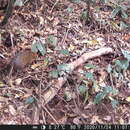Checkered sengi or checkered elephant shrew (Rhynchocyon cirnei)
(
англиски
)
добавил EOL authors
The checkered sengi or elephant shrew lives in central and southeast Africa (Uganda, southern Tanzania, northern Zaire, northern and eastern Democratic Republic of Congo, northern and central Mozambique, northeastern Zambia and Malawi). Some maps show the sengi to occur in extreme southern Central African Republic, based on an individual said to have been collected between Bangui and Mbaiki west of the Ubangi River (IUCN, Wikipedia). The sengi prefers subtropical and tropical moist lowland and montane tropical rainforests. It also lives in subtropical or tropical dry forests, closed-canopy woodlands, forest mosaics (open woodlands and woodland mosaics), scrub forest, grasslands, riparian forests and thickets ,where the substrate is usually covered with dense leaf litter, shrublands, bushlands, subtropical or tropical dry shrubland and croplands. It is well adapted to areas with a plentiful supply of food and water year round. The habitats are often fragmented and isolated due to natural and anthropogenic activities, resulting in isolated and sometimes small populations (IUCN). The body length is 22.9-30.5 cm, the tail length is 17.8-25.4 cm and the weight is 408-550 g. The coat has several dark stripes running on either side of the body. The “checkered” on the back comprises chestnut and off-white colors on a background of beige to yellowish brown to dark brown. The hind legs are longer than the fore limbs, hence a hunchbacked posture. The forelimbs have 3 long claws used to excavate small holes in the ground. There is a long, tapering tail, with scent glands just behind the anus. The tongue is used to pick up small food items and extends well beyond the edge of the elongated proboscis, which continually twitches in a hesitant, circular motion and is used as a tool and sense organ (ADW). The nostrils are on the forward end of the snout and long sensory whiskers arise from its base. The relatively long digestive tract has a caecum and the reproductive tract has several distinctive features. Males have larger canines than do females. It uses visual perception in territorial encounters and also uses scent signals to communicate. The scent gland, just behind the anus, is used to mark territories. When sengis forage together, they make continuous squeals and squeaks to maintain group unity. When they are alarmed, they slap their tail on the ground or tail-rap. The sengi eats invertebrates such as ants, termites, centipedes and earthworms, as well as beetles and their larvae, small mammals, amphibians, molluscs, birds and bird eggs. Its primary predators include snakes, humans and birds of prey. The sengi is cryptically colored and uses warning signals to warn each other about the presence of predators (ADW). The sengi forms monogamous pairs for life (ADW, IUCN, Wikipedia); a pair defends a territory of a few acres (Wikipedia). The female has 1-3 young at a time, 4-5 times a year, throughout the year (ADW). The gestation period lasts 42 days and the reproductive rate is relatively low (IUCN). The mother can gestate and lactate at the same time. The highly precocial young is born with hair, stays in the nest for 2 weeks and is fully weaned by 2 weeks. It follows the mother while she forages. It can survive on its own 5 days after it leaves the nest, but stays with the parents for an extra 5-10 weeks after weaning, while trying to establish its territory. It leaves the parents' supervision when it finds a territory and a mate (ADW). The sengi probably lives for 4-5 years (ADW); a captive lived for 4.5 years (AnAge). The IUCN classifies the sengi in the 'Vulnerable' or 'Near Threatened' threat category (ADW, IUCN). The sengi is probably experiencing loss and fragmentation of forest habitat due to human activities, with an assumed decline in numbers as habitats are degraded and lost (IUCN, Wikipedia). It is vulnerable to habitat fragmentation, decline in forested areas and quality of habitats due to human activities (IUCN). Hunting for food may be a localized threat (IUCN). Except for indirect protection in reserves and parks, there are no specific conservation initiatives directed towards the sengi, but efforts to protect primates and antelopes in forest habitats may indirectly benefit it (IUCN). R. c. hendersoni is restricted to an isolated montane forest in Malawi, which may be disappearing due to clearing (IUCN). R. c. cirnei is known from the type specimen from a restricted area in coastal Mozambique (IUCN). R. c. macrurus lives in coastal areas of southern Tanzania and northern Mozambique (IUCN).

